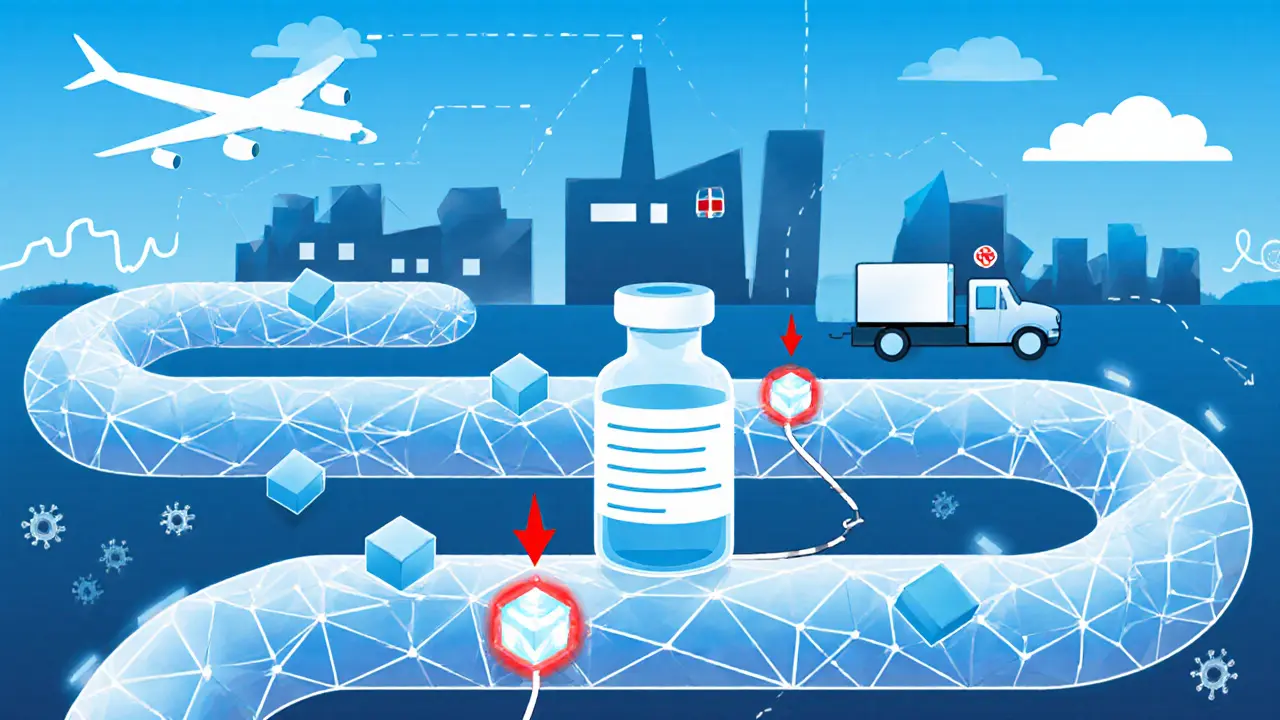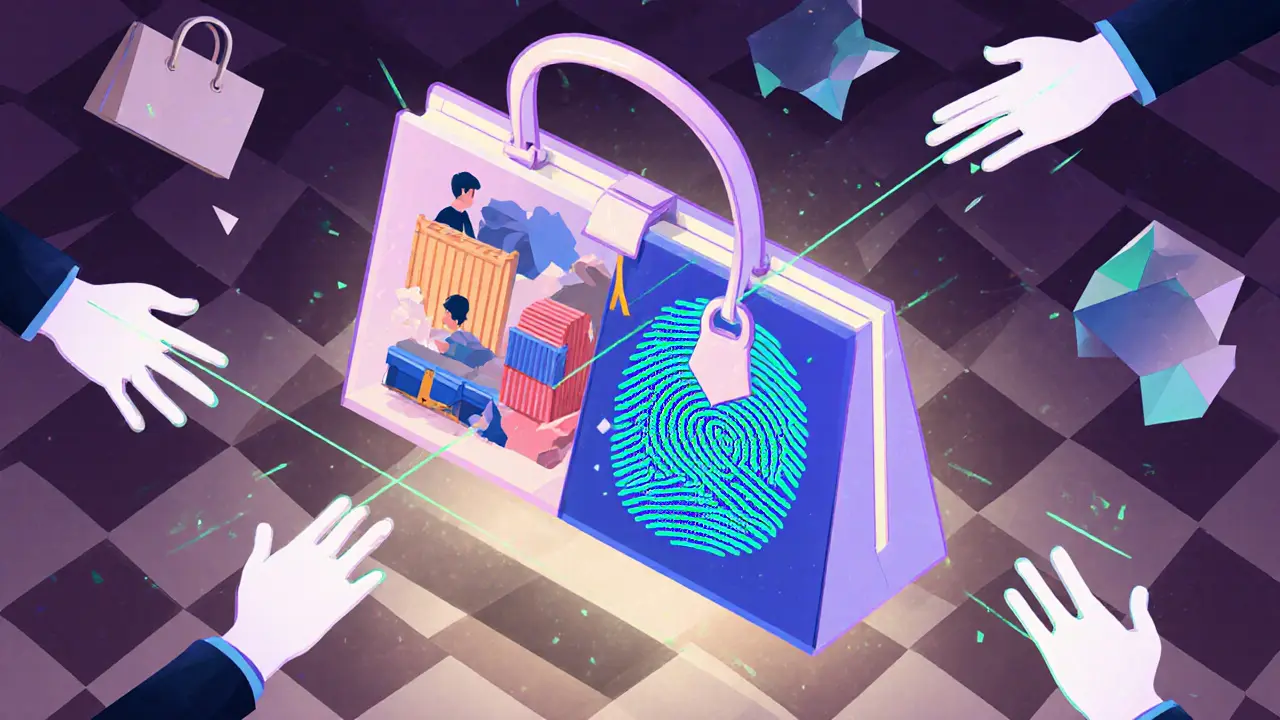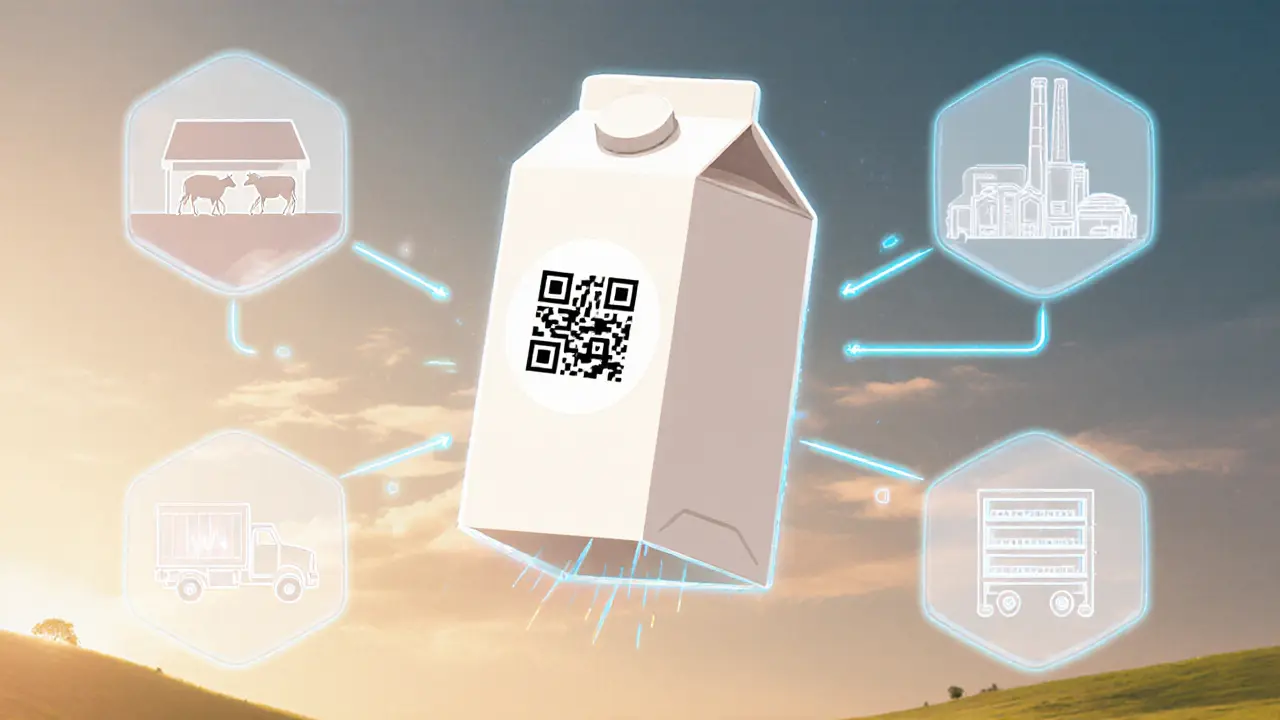Supply Chain Recall Time Calculator
See how blockchain technology can transform product recall situations. With traditional supply chains, tracing products can take days or even weeks. With blockchain, it happens in seconds. Calculate your potential time and cost savings below.
Recall Information
Results
Enter details above to see your potential savings
Imagine you buy a carton of milk. You scan a QR code on the box, and instantly see every stop it made: which farm the cows were on, when it was pasteurized, which truck carried it, and even the temperature inside the container during transit. If there’s a recall, you know exactly which batches are affected - not because someone guessed, but because the system knows. This isn’t science fiction. It’s blockchain in supply chains, and it’s already saving companies millions.
Why Supply Chains Need Blockchain
Traditional supply chains are messy. Paper bills of lading, spreadsheets, disconnected systems, and manual checks create delays, errors, and fraud. A single product might pass through 20+ hands before reaching you. If something goes wrong - contaminated food, a fake part, a delayed shipment - tracing the problem can take weeks. In some cases, like food recalls, it takes up to two months to find the source. That’s too slow when lives are at risk. Blockchain fixes this by creating a single, shared digital ledger. Every transaction, every movement, every temperature reading gets recorded in real time. Once written, it can’t be changed. Everyone in the chain - farmer, processor, shipper, retailer - sees the same data. No more arguing over who did what or when. No more lost paperwork. Just facts, locked in place.Food Safety: Cutting Recall Time from Months to Seconds
Walmart was one of the first big retailers to push blockchain for food. Before blockchain, tracing a bag of mangoes back to its farm took nearly seven days. After implementing IBM’s Food Trust blockchain, they cut that time to 2.2 seconds. How? Every time the mangoes changed hands - from farm to packing plant to warehouse to store - the event was logged. Temperature, humidity, shipping time, inspection results. If a batch tests positive for salmonella, the system instantly pulls up every store that received it, every date it was sold, and even which customers might have bought it. No guesswork. No wasted product. No lost trust. Companies like Carrefour and Nestlé followed. In Europe, blockchain is now used to track everything from chicken to olive oil. German startup Tracifier helped food processors cut operational costs by up to 40% by automating inventory checks and reducing manual audits with Oracle Blockchain.Pharmaceuticals: Keeping Vaccines Safe from Farm to Syringe
Cold chain logistics are brutal. Some vaccines need to stay at -70°C from the factory to your arm. One degree too warm, and the whole batch is ruined. During the COVID-19 pandemic, Moderna used blockchain to track every vial of vaccine. Sensors inside shipping containers recorded temperature, shock, and light exposure in real time. If a container overheated, the system flagged it immediately. Everyone - manufacturer, airline, hospital - got the alert at the same time. This wasn’t just about saving money. It was about saving lives. The FDA and WHO now recommend blockchain for high-value drugs. In the U.S., the Drug Supply Chain Security Act requires traceability by 2023 - and blockchain is the only technology that meets the standard fully.Diamonds and Luxury Goods: Stopping Fraud at the Source
Conflict diamonds have plagued the jewelry industry for decades. De Beers, the world’s largest diamond producer, launched Tracr - a blockchain platform that tracks every diamond from mine to retail. Each stone gets a digital fingerprint. You can see where it was mined, who cut it, and where it was polished. No more “blood diamonds” slipping through. Luxury brands like LVMH (Louis Vuitton, Dior) use similar systems. If you buy a $5,000 handbag, you can scan a tag and verify it’s real - not a knockoff made in a basement factory. This isn’t just about branding. It’s about value. Customers pay more for authenticity.
Automotive: Tracking Cobalt for Electric Car Batteries
Electric cars need lithium-ion batteries. Those batteries need cobalt. Most cobalt comes from the Democratic Republic of Congo, where child labor and unsafe mining are common. Ford Motor Company started using blockchain in 2020 to track cobalt from mine to battery plant. They partnered with suppliers to log every ton of cobalt, ensuring it came from ethical sources. This isn’t charity. It’s compliance. The EU and U.S. are passing laws that require companies to prove their supply chains are clean. Blockchain makes that proof automatic. No audits. No lies. Just data.Oil, Shipping, and Logistics: Automating the Invisible
Abu Dhabi National Oil Company (ADNOC) uses blockchain to track oil from the wellhead to the customer. Every transfer, every inspection, every customs clearance is recorded. No more delays from paperwork. No more disputes over who signed what. FedEx joined the Blockchain in Transport Alliance (BiTA) to fix one of the biggest headaches in logistics: lost or disputed shipments. With blockchain, every signature, every scan, every delay is timestamped. If a customer claims their package arrived damaged, the system shows the exact moment the damage occurred - and who was responsible. Fish supplier John West did something simple but powerful: they put a QR code on every can of tuna. Scan it, and you see the name of the fisherman, the boat, the date it was caught, and the route it took. Customers care. Sales went up.Smart Contracts: The Invisible Hand That Pays and Punishes
Blockchain doesn’t just record data - it acts on it. Smart contracts are self-executing rules written into the blockchain. If the temperature of a shipment drops below -70°C for more than 15 minutes, the contract automatically flags the batch as spoiled and notifies the insurer. If a shipment arrives late, the contract triggers a penalty payment to the buyer. If a supplier delivers on time and meets quality standards, they get paid instantly - no invoices, no waiting. This removes middlemen. No more brokers, no more manual approvals. Payments happen automatically. Delays are punished. Quality is rewarded. It’s not magic. It’s code.
What’s Next? Tokenization, AI, and Decentralized Finance
The next wave is tokenization. That means turning physical goods into digital tokens on the blockchain. A shipment of coffee beans becomes a token. You can sell half of it. You can use it as collateral for a loan. Small farmers who couldn’t get credit before can now borrow against their inventory. Combine that with AI, and you get predictive supply chains. If sensors show a storm is coming, the system reroutes shipments automatically. If demand spikes in one region, inventory shifts in real time. Oracle and IBM are already testing this. Decentralized finance (DeFi) platforms are starting to offer supply chain loans based on blockchain data. No bank branch. No credit check. Just proof of delivery, and instant funding.Challenges? Yes. But They’re Solvable
Blockchain isn’t perfect. Setting it up costs money. You need sensors, software, and training. Smaller suppliers might struggle to join. But platforms like Oracle Blockchain and IBM Food Trust are making it easier. You don’t have to build from scratch. You can plug in. The bigger challenge is trust. Some companies still think blockchain is just a buzzword. But the numbers don’t lie. Companies using it report 30-50% faster traceability, 20-40% lower administrative costs, and fewer disputes. In food, pharma, and luxury goods, it’s no longer optional - it’s expected.Final Thought: Transparency Is the New Competitive Edge
Customers want to know where their stuff comes from. Regulators demand proof. Investors care about risk. Blockchain delivers all three. It turns supply chains from black boxes into open books. The companies winning now aren’t the biggest. They’re the ones who see supply chains not as cost centers - but as trust engines.How does blockchain improve supply chain transparency?
Blockchain creates a single, shared digital record that every participant in the supply chain can see. Every movement, temperature change, inspection, or payment is recorded in real time and cannot be altered. This eliminates information silos and gives everyone the same truth - from the farmer to the customer.
Can blockchain prevent counterfeit products?
Yes. By giving each product a unique digital identity tied to its origin and journey, blockchain makes counterfeiting extremely difficult. Brands like De Beers and LVMH use it to verify authenticity. Customers scan a QR code to see the full history - proving the item is genuine.
What industries benefit most from blockchain in supply chains?
Food and pharmaceuticals lead because of strict safety rules. Luxury goods use it to fight counterfeits. Automotive companies track battery materials like cobalt for ethical sourcing. Shipping and logistics firms reduce disputes and delays. All of them save time and money.
Is blockchain expensive to implement?
Initial setup can cost tens of thousands, especially if you need sensors for temperature or location tracking. But platforms like Oracle Blockchain and IBM Food Trust offer ready-made solutions. Many companies recover costs within a year through reduced waste, faster recalls, and lower admin fees.
Do I need to replace my current ERP system to use blockchain?
No. Most blockchain platforms integrate with existing ERP systems like SAP or Oracle. You don’t throw out your old software - you add a transparent layer on top. Data flows between systems automatically.
Can small suppliers use blockchain too?
Yes. Platforms like Tracifier and VeChain offer low-cost entry points. Some even let small suppliers use mobile apps to log data. Once they’re on the network, they gain access to better financing, faster payments, and bigger buyers who require blockchain traceability.
How is blockchain different from a regular database?
A regular database is controlled by one company - they can edit or delete entries. Blockchain is distributed. No one person owns it. Once data is added, it’s permanent and visible to all authorized parties. That’s what makes it tamper-proof and trustworthy.
What’s the biggest mistake companies make when starting with blockchain?
Trying to do everything at once. Start small - track one product line, one supplier, or one type of shipment. Prove the value. Then expand. Don’t wait for perfection. The goal is to get data flowing, not to build a perfect system overnight.

DeeDee Kallam
November 2, 2025 AT 00:16omg this is literally life changing i had no idea my milk could tell me where the cow was born lmao
Josh Serum
November 2, 2025 AT 10:23Actually, most of this is just repackaged RFID with a blockchain sticker. The real magic is in the sensors and integration-not the ledger. You don’t need blockchain to track temperature. You need good data pipelines. Blockchain just makes it look fancy while adding latency and cost. I’ve seen companies spend $2M on this and still have Excel sheets running the show behind the scenes.
Helen Hardman
November 3, 2025 AT 23:36Okay but imagine if every single thing we bought-our sneakers, our coffee, our phone-could tell its whole story? Like, your coffee didn’t just come from a farm, it came from Maria’s hands in Colombia, who woke up at 4am to pick those beans, and the truck driver who drove it through the rain, and the barista who smiled when they handed it to you? That’s not just tech-that’s connection. And that’s what makes us human. We’re not just buying products anymore, we’re buying trust, history, and soul. Blockchain just gives us the keys to the story.
Elizabeth Melendez
November 4, 2025 AT 11:21soooo true!! i work at a small organic grocer and we just started using a blockchain platform for our eggs and honestly?? our customers are obsessed. they scan the code and get all this history-like the coop name, the feed they ate, even the weather that day. sales went up 30% and we get DMs like ‘i cried reading about henry the rooster’ lol. it’s not just about safety, it’s about feeling close to your food. and guess what? our supplier got a loan from a crypto farm lender because their blockchain data proved they’re reliable. mind blown.
Phil Higgins
November 5, 2025 AT 05:00Transparency is not a feature. It is a moral imperative. The systems we build should reflect the dignity of labor, the sanctity of life, and the accountability of power. Blockchain, in this context, is not a tool-it is a covenant. A promise that no child will be exploited in silence, that no vaccine will be lost to negligence, that no diamond will carry blood without consequence. We are not optimizing supply chains. We are rebuilding ethics.
Genevieve Rachal
November 6, 2025 AT 03:37Everyone’s acting like blockchain is the answer, but let’s be real-most of these case studies are cherry-picked. Walmart’s mango thing? Great. But what about the 80% of small farms in Africa that don’t have smartphones, let alone QR scanners? Or the fact that blockchain doesn’t stop fraud-it just moves it to the data entry stage? If someone inputs fake temps, the blockchain just records the lie perfectly. You’re not fixing the problem. You’re automating the lie.
Malinda Black
November 6, 2025 AT 21:06I think the real win here is how this empowers small players. I used to think blockchain was for big corps, but after talking to a coffee farmer in Guatemala who now gets paid instantly because his shipment data is verified on-chain… it hit me. This isn’t just about tracking. It’s about giving voice to people who’ve been invisible in the system for centuries. It’s quiet revolution stuff.
Chris Strife
November 7, 2025 AT 23:53Blockchain in supply chains is a socialist fantasy dressed in tech jargon. America built its economy on free markets and private records. Now we’re forcing everyone to share data on some global ledger because tech bros think transparency is a virtue? Wake up. If you want to track your milk, use a barcode. Stop giving governments and NGOs a backdoor into every transaction. This is surveillance with a blockchain logo.
Mehak Sharma
November 9, 2025 AT 03:57Imagine a world where a farmer in Punjab can sell his wheat directly to a bakery in Toronto because the blockchain proves his crop is organic and his labor ethical. No middlemen. No delayed payments. No corruption. Just code and trust. This is not just innovation-it is liberation. The future belongs not to the biggest players but to the most transparent ones. And yes, the tech is still young, but the vision? Eternal.
bob marley
November 10, 2025 AT 11:02Oh wow so now my toothpaste has a blockchain ID? Next they’ll tell me my socks know where they were woven. This is the most expensive form of digital yoga I’ve ever seen. Just scan a QR code to see who breathed on it. I’m sold.
Jeremy Jaramillo
November 12, 2025 AT 00:15I’ve worked in logistics for 22 years. I’ve seen every ‘revolution’ come and go-RFID, AI, EDI, cloud. But this one? This one feels different. Not because it’s perfect. But because it finally gives the people on the ground-the drivers, the warehouse clerks, the quality inspectors-a voice. The data doesn’t lie. And when the data doesn’t lie, people start trusting each other again. That’s worth more than any cost savings.